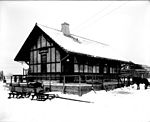Village of Monroe Historic District

The Village of Monroe Historic District, also known as the Smith's Mill Historic District, is located in Monroe, New York, United States. It is an irregularly shaped 81-acre (33 ha) area containing 36 properties, primarily residential but with some churches and commercial buildings, in the center of the village, just east of its downtown. In 1998 it was listed on the National Register of Historic Places. Most of the district is open space, taken up by a mill pond and park, a cemetery and the former site of a racetrack. Its buildings, mostly from the 19th century but some predating the Revolution, are clustered in a small area Stage Road and represent the early core of Monroe from the days when Smith's Mill, its first business, had dammed the waters of Ramapo Creek. They are also survivors of an 1892 fire that devastated the village. The Greek Revival and Federal architectural styles prevail, with some mid-19th-century Gothic Revival homes included. Among the contributing properties are the oldest Masonic Lodge in New York, and the home of David Smith, the village's first settler.
Excerpt from the Wikipedia article Village of Monroe Historic District (License: CC BY-SA 3.0, Authors, Images).Village of Monroe Historic District
Stage Road,
Geographical coordinates (GPS) Address Nearby Places Show on map
Geographical coordinates (GPS)
| Latitude | Longitude |
|---|---|
| N 41.324166666667 ° | E -74.186944444444 ° |
Address
Stage Road 310
10950
New York, United States
Open on Google Maps








